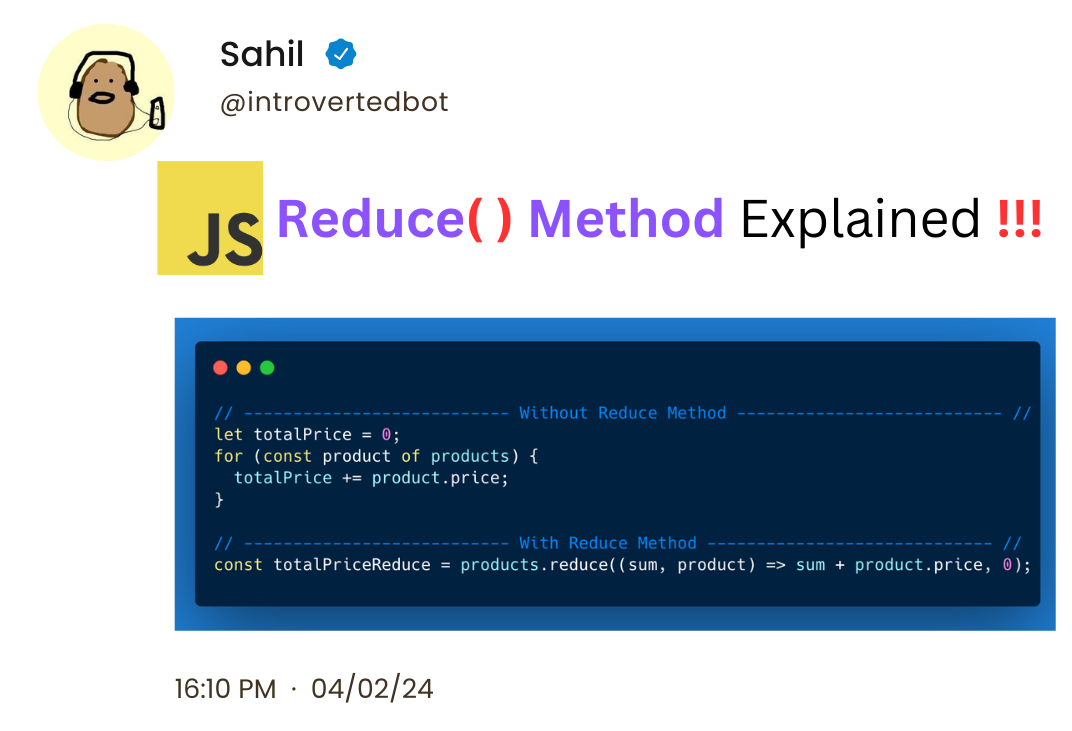Introduced alongside other array methods in ECMAScript 5, reduce() offers a unique and powerful way to transform arrays into single values.
In this article, you'll learn about the reduce() method by understanding what it is, its syntax, and finally you'll see some use cases where you can use it effectively.
You can get all the source code from here.
Table of Contents
- Understanding the Fundamentals of
reduce() - Think of it Like Sculpting Clay
- Use Cases of
reduce() - Conclusion
Understanding the Fundamentals of reduce()
At its heart, reduce() iterates through each element of an array, applying a user-defined function (aptly named the "reducer") to both the current element and an accumulator value.
This accumulator starts with an initial value you provide (or defaults to the first array element) and gets updated with the return value of the reducer in each iteration.
Ultimately, the final state of the accumulator becomes the single value returned by reduce().
Think of it Like Sculpting Clay
Imagine shaping a piece of clay. You start with a lump and repeatedly apply pressure and direction, transforming it into the desired form.
Similarly, reduce() takes an initial value (the clay) and, through your custom reducer function (your sculpting hands), molds it into the final result.
Use Cases of reduce()
Now, let's delve into some scenarios where reduce() shines:
Calculating Totals
Scenario: You have an array of objects representing products, and you want to calculate the total price of all products.
Traditional approach with a loop:
const products = [
{ name: "Shirt", price: 20 },
{ name: "Shoes", price: 50 },
{ name: "Hat", price: 15 }
];
// Initialize totalPrice to 0
let totalPrice = 0;
// Loop through each product and add its price to totalPrice
for (const product of products) {
totalPrice += product.price;
}
console.log("Total price (loop):", totalPrice); // Output: Total price (loop): 85
The traditional approach initializes a variable totalPrice to 0, then iterates through each product in the products array using a for...of loop.
Inside the loop, it adds the price property of the current product to the totalPrice.
After iterating through all products, the final totalPrice (85) is printed to the console.
Using reduce():
const products = [
{ name: "Shirt", price: 20 },
{ name: "Shoes", price: 50 },
{ name: "Hat", price: 15 }
];
// Use reduce() with an initial value of 0 for totalPrice
const totalPriceReduce = products.reduce((sum, product) => sum + product.price, 0);
console.log("Total price (reduce):", totalPriceReduce); // Output: Total price (reduce): 85
The reduce() method takes a callback function and an optional initial value (0 in this case). The callback function receives two arguments: sum, the accumulator, initially set to the initial value (0), and product, the current product object.
Inside the callback function, the price property of the current product is added to the sum. The return value of the callback function becomes the new sum for the next iteration.
After iterating through all products, the final sum (85) is returned and stored in totalPriceReduce.
Comparison: Both approaches achieve the same result, but reduce() offers a more concise and functional way to calculate the total price. It avoids the need for an explicit loop and directly expresses the logic of adding prices within the callback function.
Finding Minimum or Maximum Values
Scenario: You have an array of temperatures and want to find the highest and lowest temperatures.
Traditional approach with loops:
const temperatures = [25, 18, 32, 20, 15];
// Initialize maxTemp and minTemp to unrealistic values
let maxTemp = -Infinity;
let minTemp = Infinity;
// Loop through each temperature and update maxTemp and minTemp
for (const temp of temperatures) {
maxTemp = Math.max(maxTemp, temp);
minTemp = Math.min(minTemp, temp);
}
console.log("Max temp (loop):", maxTemp); // Output: Max temp (loop): 32
console.log("Min temp (loop):", minTemp); // Output: Min temp (loop): 15
The traditional approach initializes maxTemp to negative infinity and minTemp to positive infinity to ensure they are updated with the first encountered temperature.
It then iterates through each temperature in the temperatures array using a for...of loop. Inside the loop, it uses Math.max() to compare the current maxTemp with the current temperature and updates maxTemp if necessary.
Similarly, it uses Math.min() to compare the current minTemp and update it if needed. After iterating through all temperatures, the final maxTemp (32) and minTemp (15) are printed to the console.
Using reduce():
const temperatures = [25, 18, 32, 20, 15];
// Use reduce() with initial values of -Infinity and Infinity
const maxTempReduce = temperatures.reduce((max, temp) => Math.max(max, temp), -Infinity);
const minTempReduce = temperatures.reduce((min, temp) => Math.min(min, temp), Infinity);
console.log("Max temp (reduce):", maxTempReduce); // Output: Max temp (reduce): 32
console.log("Min temp (reduce):", minTempReduce); // Output: Min temp (reduce): 15
The reduce() method takes a callback function and an initial value (negative and positive infinity in this case). The callback function receives two arguments: max or min, the accumulator, starting as the initial values, and temp, the current temperature.
Inside the callback function, Math.max() or Math.min() is used to compare the current temperature with the accumulator and update it accordingly.
After iterating through all temperatures, the final maximum and minimum temperatures are returned.
Comparison: Both approaches achieve the same result, but reduce() offers a more concise and functional way to find the maximum and minimum values. It leverages the accumulator concept to directly compare and update the values within the callback function.
Building Complex Objects:
Scenario: You have an array of students and want to group them by their subjects into a single object.
Traditional approach with loops:
const students = [
{ name: "Alice", age: 25, subject: "Math" },
{ name: "Bob", age: 30, subject: "Science" },
{ name: "Charlie", age: 28, subject: "History" },
];
// Initialize an empty object to store subject groups
const subjectMap = {};
// Loop through each student and add them to their respective subject group
for (const student of students) {
const subject = student.subject;
if (!subjectMap
[subject]) {
subjectMap[subject] = [];
}
subjectMap[subject].push(student);
}
console.log("Subject map (loop):", subjectMap); // Output: { Math: [...], Science: [...], History: [...] }
This approach initializes an empty object subjectMap to store the grouped students. It then iterates through each student in the students array using a for...of loop.
Inside the loop, it retrieves the student's subject. If the subject doesn't exist as a key in subjectMap, a new array is created for that subject. The current student object is then pushed into the corresponding subject array within subjectMap.
After iterating through all students, the final subjectMap object contains groups of students based on their subjects.
Using reduce():
const students = [
{ name: "Alice", age: 25, subject: "Math" },
{ name: "Bob", age: 30, subject: "Science" },
{ name: "Charlie", age: 28, subject: "History" },
];
// Use reduce() to build the subject map object
const subjectMapReduce = students.reduce((map, student) => {
const subject = student.subject;
map[subject] = map[subject] || [];
map[subject].push(student);
return map;
}, {});
console.log("Subject map (reduce):", subjectMapReduce); // Output: { Math: [...], Science: [...], History: [...] }
The reduce() method takes a callback function and an initial value (an empty object in this case). The callback function receives two arguments: map, the accumulator, starting as the initial empty object, and student, the current student object.
Inside the callback function, the subject property of the current student is retrieved. If the subject doesn't exist in map, an empty array is created for it. The current student object is pushed into the corresponding subject array within map.
The updated map object is returned as the new accumulator for the next iteration. After iterating through all students, the final map object contains the grouped students.
Comparison: Both approaches achieve the same result, but reduce() offers a more concise and functional way to build the object. It leverages the accumulator concept to directly build the subjectMap within the callback function.
Flattening Multidimensional Arrays:
Scenario: You have a nested array structure and want to create a single-level array.
Traditional approach with loops:
const multiArray = [[1, 2], [3, 4], [5]];
// Initialize an empty array to store flattened elements
const flatArray = [];
// Loop through each sub-array and push its elements into flatArray
for (const subArray of multiArray) {
for (const element of subArray) {
flatArray.push(element);
}
}
console.log("Flat array (loop):", flatArray); // Output: [1, 2, 3, 4, 5]
This approach initializes an empty array flatArray to store the flattened elements. It then iterates through each sub-array in the multiArray using a nested for...of loop.
Inside the inner loop, each element of the current sub-array is pushed into flatArray. After iterating through all sub-arrays, the final flatArray contains all elements in a single level.
Using reduce():
const multiArray = [[1, 2], [3, 4], [5]];
// Use reduce() to flatten the multidimensional array
const flatArrayReduce = multiArray.reduce((accumulator, currentArray) => {
return accumulator.concat(currentArray);
}, []);
console.log("Flat array (reduce):", flatArrayReduce); // Output: [1, 2, 3, 4, 5]
The reduce() method takes a callback function and an initial value (an empty array [] in this case). The callback function receives two arguments: accumulator, the accumulator, starting as the initial empty array, and currentArray, the current sub-array being processed.
Inside the callback function, the concat() method is used to concatenate the currentArray with the accumulator, effectively flattening the array. The result of concat() becomes the new accumulator for the next iteration.
After iterating through all sub-arrays, the final accumulator contains all elements of the multidimensional array flattened into a single level.
Comparison: Both approaches achieve the same result of flattening the array, but reduce() provides a more elegant and concise solution. It leverages the accumulator concept to gradually build the flattened array, avoiding the need for nested loops and manual pushing of elements.
Conclusion
In summary, the reduce() method in JavaScript provides a concise and powerful way to transform arrays into single values or complex data structures.
By offering flexibility through a customizable reducer function and an optional initial value, reduce() simplifies common tasks such as calculating totals, finding extremes, grouping objects, and flattening arrays.
Understanding reduce() empowers developers to write cleaner, more efficient code and opens up new possibilities for data manipulation in JavaScript projects.
If you have any feedback, then DM me on Twitter or LinkedIn.

